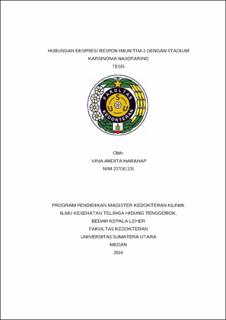Hubungan Ekspresi Respon Imun TIM-3 dengan Stadium Karsinoma Nasofaring
Association of TIM-3 Immune Response Expression with the Stage of Nasopharyngeal Carcinoma
Abstract
Background: Nasopharyngeal carcinoma (NPC) is a head and neck malignancy
predominantly found in endemic regions such as Southeast Asia, including
Indonesia. Its development and progression are closely related to immune escape
mechanisms. T-cell immunoglobulin and mucin domain-containing protein-3
(TIM-3) is recognized as an immune checkpoint that negatively regulates immune
responses and has been reported to correlate with poor prognosis in several
cancers. However, the association between TIM-3 expression and NPC stage
remains inconsistent and requires further investigation.
Objective: To evaluate the association between TIM-3 immune response
expression and the clinical stage of nasopharyngeal carcinoma.
Methods: This study was an analytical observational research with a crosssectional
design involving 40 NPC patients. Demographic characteristics,
histopathological type, tumor extension (T), lymph node involvement (N), and
clinical stage were analyzed in relation to TIM-3 immune response expression.
Results: The majority of subjects were male (65%) with a mean age of 48.2 years.
Increased TIM-3 immune response expression was observed in 97.5% of samples.
No significant association was found between TIM-3 expression and
histopathological type, tumor extension, lymph node enlargement, or clinical
stage of NPC. Descriptively, TIM-3 expression was higher in undifferentiated
carcinoma compared to keratinizing SCC, highest in T4 compared to T1, and
highest in N3 compared to N0. The maximum expression value was observed in
stage IV.
Conclusion: TIM-3 immune response expression was increased in most NPC
cases but showed no significant correlation with clinical stage. Variations in TIM-
3 expression across tumor types and the immune microenvironment may
influence its prognostic role.

